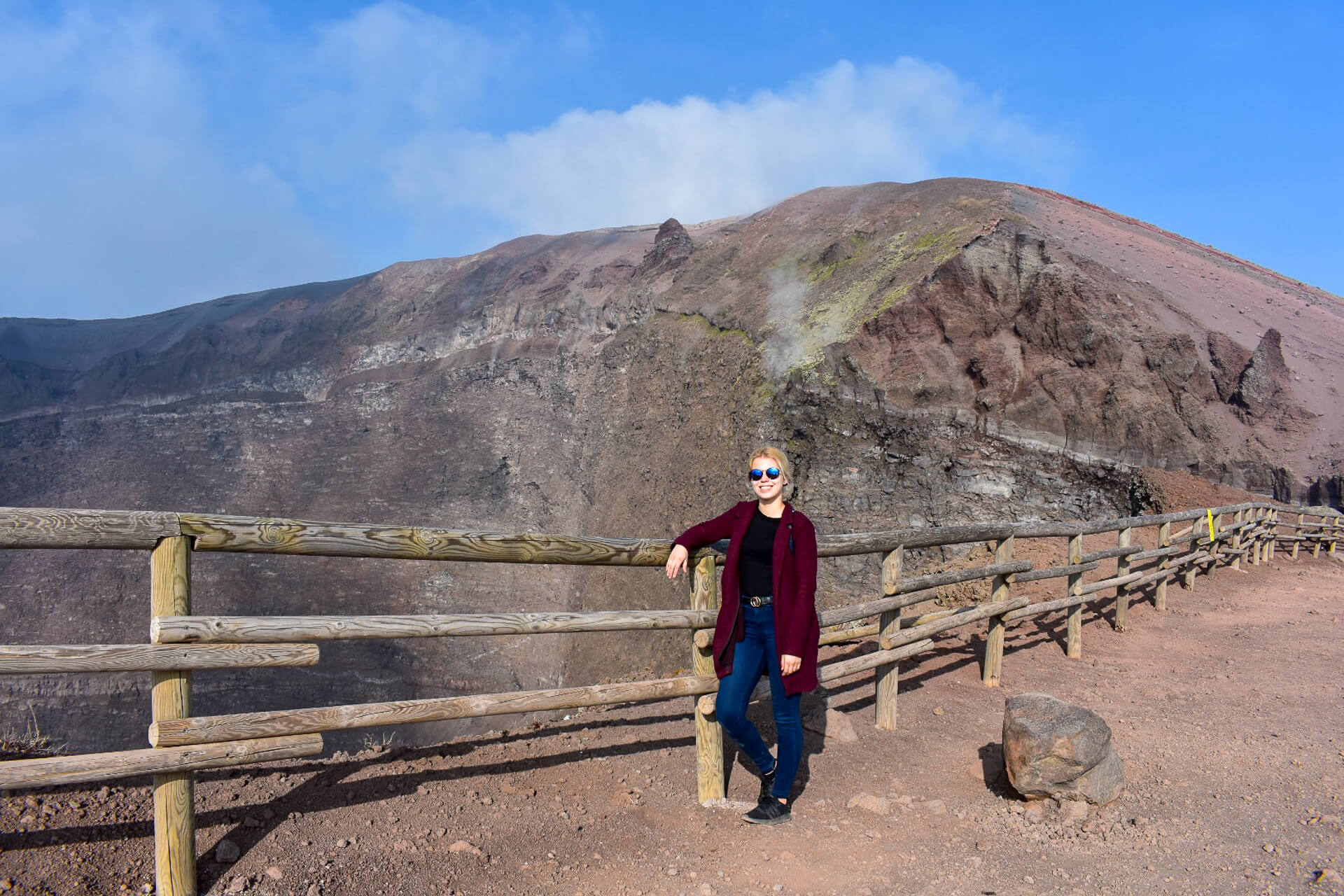This article contains affiliate links. Learn more in our affiliate disclosure.
If there’s one place that truly brings ancient history to life, it’s Pompeii and Mount Vesuvius — the infamous volcano and the city it buried almost 2,000 years ago. It’s one of those rare places where you can literally walk through the past, seeing streets the eruption froze in time.
I visited a few years back with my grandma and sister during our trip to Italy. We spent a few lovely days exploring Rome before heading south. If you’re planning the same route, our guide to where to stay in Rome breaks down the best neighborhoods and hotels for every type of trip.
Once in Naples, Pompeii and Mount Vesuvius day trip is easily combined with Amalfi Coast if you’re planning your route that way.
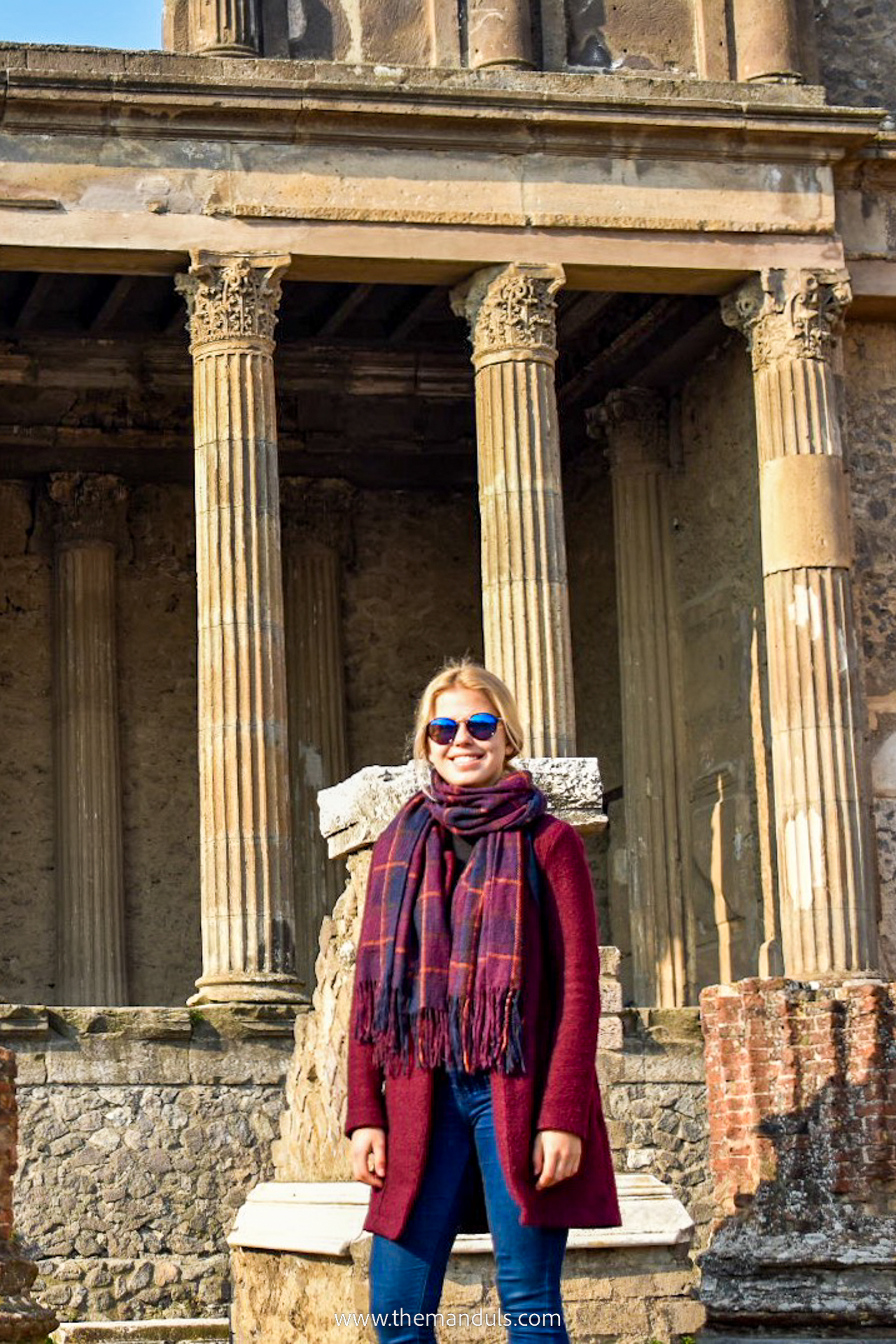
We came during the low season, and honestly, it couldn’t have been better. The air was crisp, the crowds were gone, and wandering through the ruins felt almost surreal — just us and a few other curious travelers, and the sound of gravel crunching underfoot.
If you’re planning a visit yourself, this is one of those places that deserves a bit of time — not just a quick stop. There’s so much history, scenery, and atmosphere packed into this corner of Italy, and seeing both in one trip gives you a real sense of how powerful and fragile this region is at the same time.
In this guide, I’ll share how to visit, the best ways to get there, what to expect once you arrive, and a few personal tips to help you make the most of your day.

Key Highlights
📍Location: 25 km from Naples
⭐️ Best time to visit: spring or autumn
💰 Entrance fee: from 18€ and 10€
🚗 How to get there: train, bus, guided tour
🥾Accessibility: not very stroller or wheelchair friendly
At a Glance
It looks picture-perfect in photos, but there’s one thing we didn’t expect — how huge Pompeii actually is. You could easily spend hours wandering through the old streets, villas, and amphitheatres, and still only see a fraction of it.
The surroundings are striking, with the volcano rising in the background — quiet now, but with a story that still lingers in the air.
Why visit? Because it’s one of those places that makes history feel alive. You’re not just ticking off ruins — you’re walking through a once-bustling city, seeing frescoes, mosaics, and bathhouses that survived an eruption nearly 2,000 years ago.
Combine it with a walk up to the crater of Mount Vesuvius, and you get this powerful contrast between destruction and resilience.
It’s an easy day trip from Naples (and can even fit into an Amalfi Coast itinerary), so there’s really no reason to skip it. The only thing we’d say? Give yourself enough time — it’s not a “quick stop” kind of place, and rushing through it would be a shame.
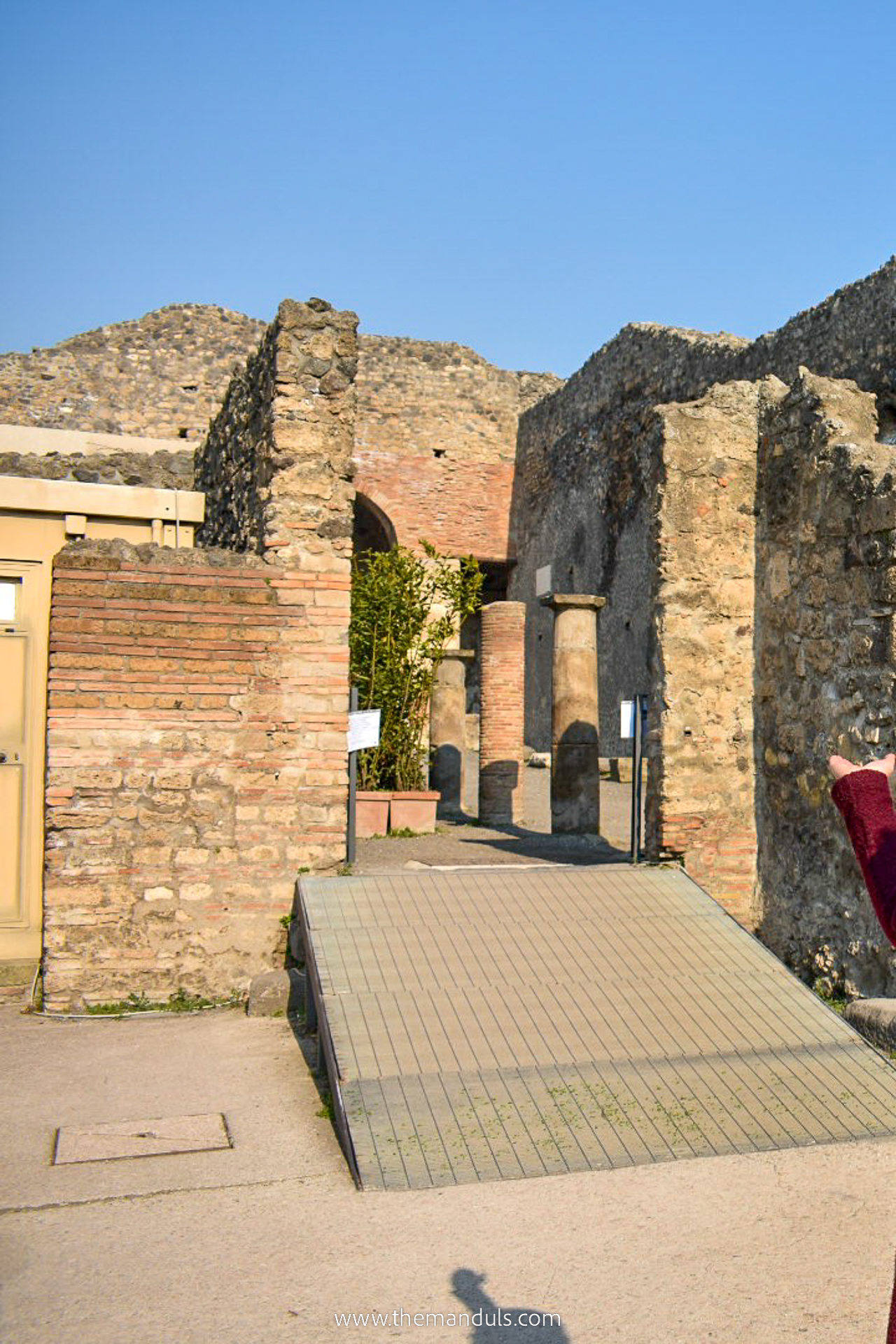
In a hurry?
These are our top hotels on Amalfi Coast we’d book again
⭐️⭐️⭐️ Amalfi Suite Boutique Hotel (our top pick) – A stylish stay in central Amalfi with elegant rooms, great breakfast, and easy access to ferries and bus routes.
👉 See prices & availability →
⭐️⭐️ Albergo Gatto Bianco – A Capri classic offering timeless charm and quiet evenings. Ideal if you’re adding an overnight stay on the island.
👉 See prices & availability →
⭐️ Hotel Sorrento City – Bright, modern, and perfectly located, this one’s ideal if you’re planning to visit Mount Vesuvius or Pompeii by train.
👉 See prices & availability →
Brief history
Pompeii was once a thriving Roman city, home to around 10,000 people, sitting peacefully at the foot of a volcano. That all changed in 79 AD, when the volcano erupted without warning, burying the entire city under a thick layer of ash and pumice.
The eruption preserved everything — streets and even the outlines of its people — creating one of the most remarkable archaeological sites in the world.
For centuries, it was forgotten, lying hidden beneath the ground until its rediscovery in the 18th century. Excavations have continued ever since, revealing more details about daily Roman life than any history book ever could.
Today, the area is a UNESCO World Heritage landmark.
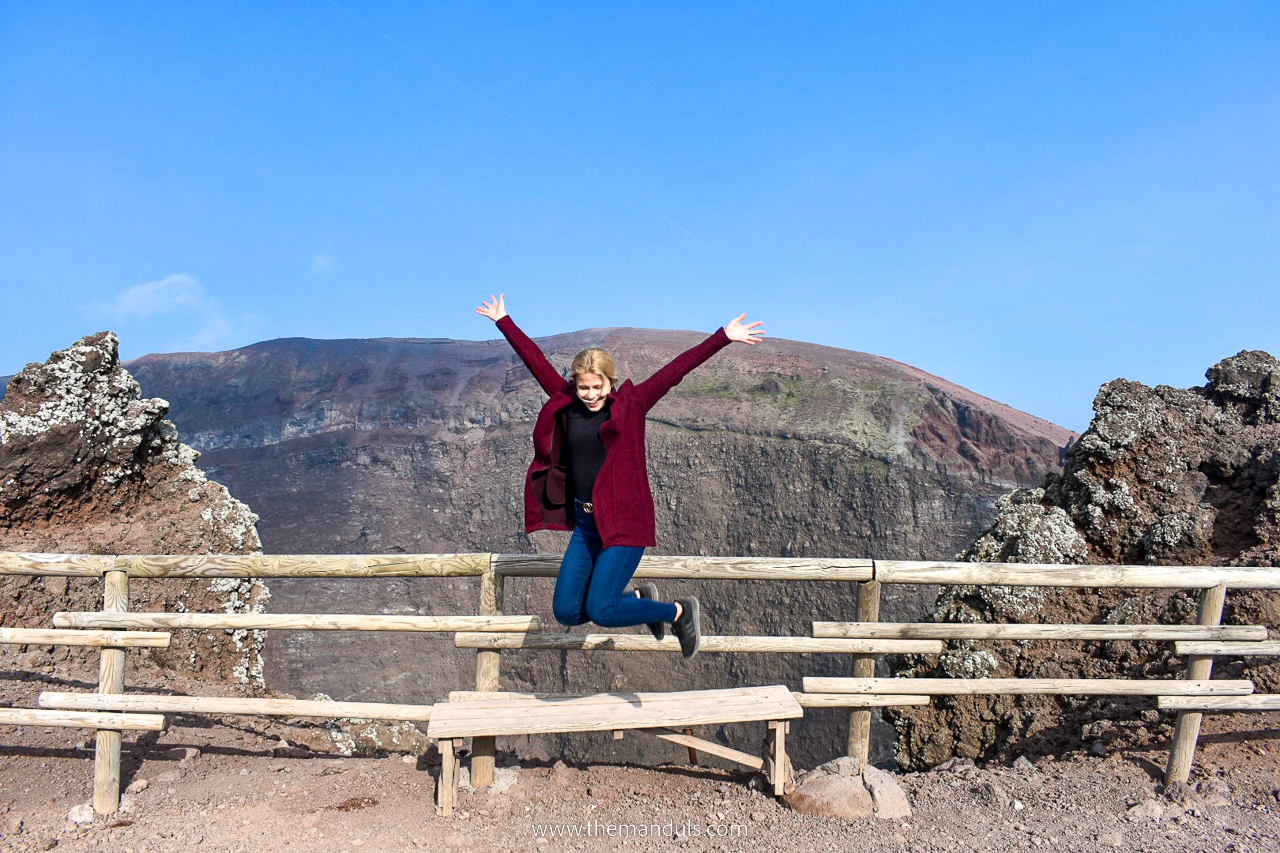
Where is Mount Vesuvius and Pompeii
Both are located in southern Italy’s Campania region, just a short trip from Naples. Pompeii lies about 25 km (40 minutes) south of Naples, and the entrance to Mount Vesuvius National Park is only another 30 minutes’ drive uphill from there.
They’re also perfectly placed if you’re exploring the Amalfi Coast — it’s roughly 45 minutes from Sorrento or 1 hour from Positano, making it an easy addition to most southern Italy itineraries.
Save the location to your Google Maps.
How to get there
Getting here is surprisingly simple, especially if you’re staying in Naples.
By public transport
The easiest and most budget-friendly way is by train — hop on the Circumvesuviana line from Napoli Garibaldi (lower floor in Napoli Centrale) and get off at Pompei Scavi – Villa dei Misteri, which drops you right near the entrance to the ruins. The journey takes between 35 and 45 minutes.
We bought our tickets (around 3€) at the station from the ticket machines. You don’t need to buy them in advance. Board the train to Sorrento. It’s a local commuter, so it can get very busy. I recommend sitting on the left side for views of the volcano.
From there, take a local EAV bus directly to the upper parking area. See the recent schedule. The ride takes 55 minutes and costs 3.1€ one way. The bus ride winds through scenic hillsides before dropping you off at the trailhead, where it’s about a 20–30 minute walk up to the crater.
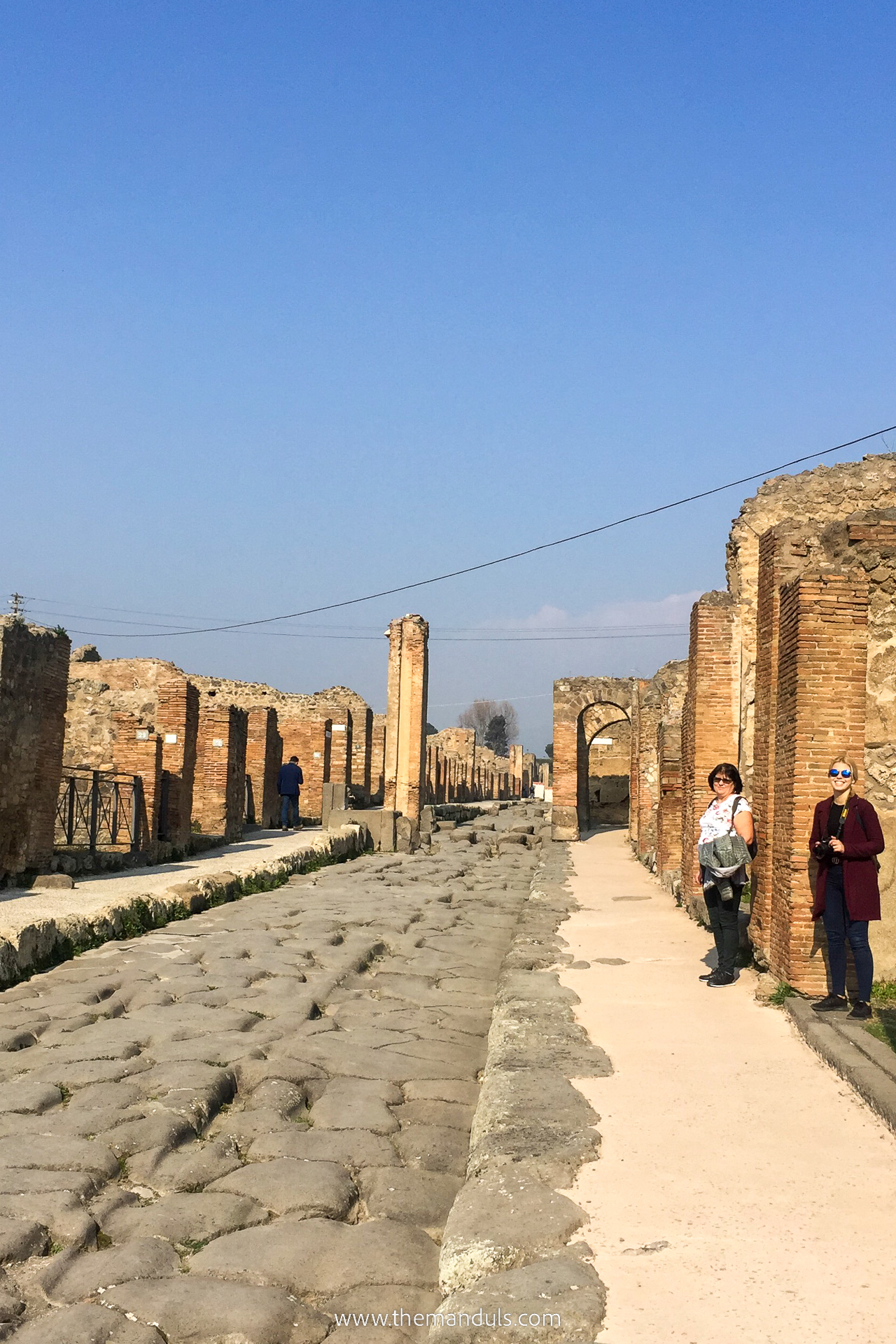
Rent a car
If you prefer more flexibility, renting a car through is another great option — it lets you visit both places at your own pace or continue south toward the Amalfi Coast afterward. Parking is easy to find near the entrances, but it can fill up quickly in summer.
Our favorite platform is DiscoverCars, where you can easily compare deals from multiple companies, see their reviews, and book your selected car. We also recommend adding a Full Coverage for complete protection and peace of mind.
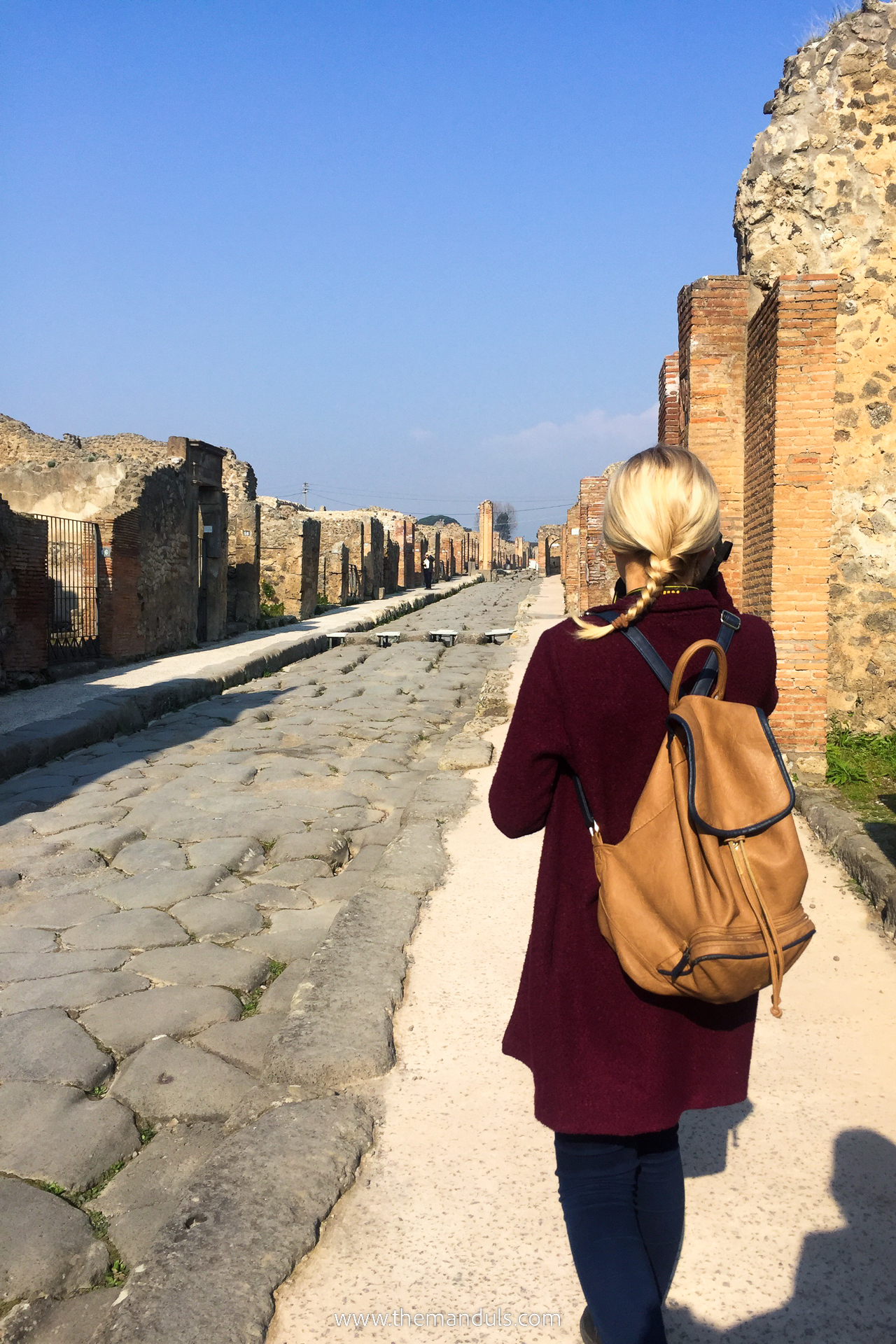
Join a day tour
If you’d rather leave the logistics to someone else, this guided day trip from Naples is one of the easiest ways to experience both highlights in a single day.
It includes round-trip transport, skip-the-line tickets, a knowledgeable guide, and even a relaxed lunch with local dishes between visits — which is a nice touch after a morning of exploring the ruins.
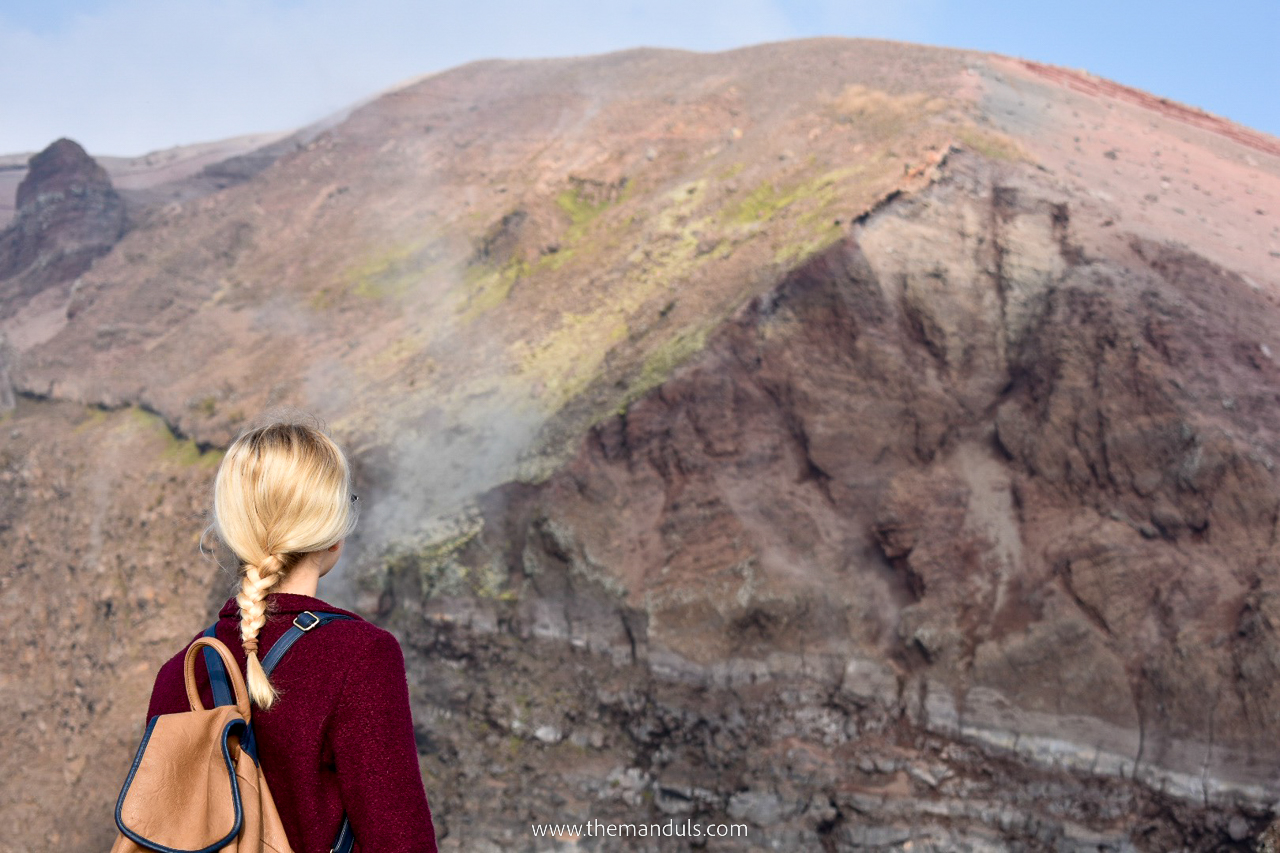
Entrance fees
Entrance Fee: from 18€ and 10€
Entry to the archaeological site costs around €18, which includes access to the main excavated areas. Tickets can be bought online on the official website in advance or directly at the gate, though queues are common in high season.
Access to the volcano’s crater requires a separate ticket priced at €10 per adult, and it’s important to know that these must be purchased online in advance for a specific time slot.
Visitor numbers are limited each day, and you’ll also need to reserve parking in advance if you’re driving. Always book through the official Vesuvius Park website, as tickets are not sold on-site.

What to expect at Pompeii and Mount Vesuvius
Pompeii
We came in February, during the low season, and it couldn’t have been a better decision. The usually busy site was calm and almost eerily quiet — no crowds, no lines, and no rush to move on.
We had no trouble finding the entrance or getting tickets on the spot, and walking through the vast ruins with only a few other visitors around felt like having an entire ancient city to ourselves.
Exploring the streets, we passed by old villas, mosaics, and bathhouses, still perfectly recognizable despite the centuries.

The moment that hit me the hardest, though, was seeing the plaster casts of people caught in the eruption — frozen in their final moments. There’s a strange stillness when you see their expressions, a mix of fear and disbelief.
It didn’t feel disturbing in the same way as modern tragedies do — maybe because it happened so long ago — but it was deeply sobering and emotional all the same.
Even though the site is large, it’s easy to navigate, with plenty of signs and some shaded spots to rest. If you visit in summer, come early — it gets hot and crowded by midday, and there’s very little shade.
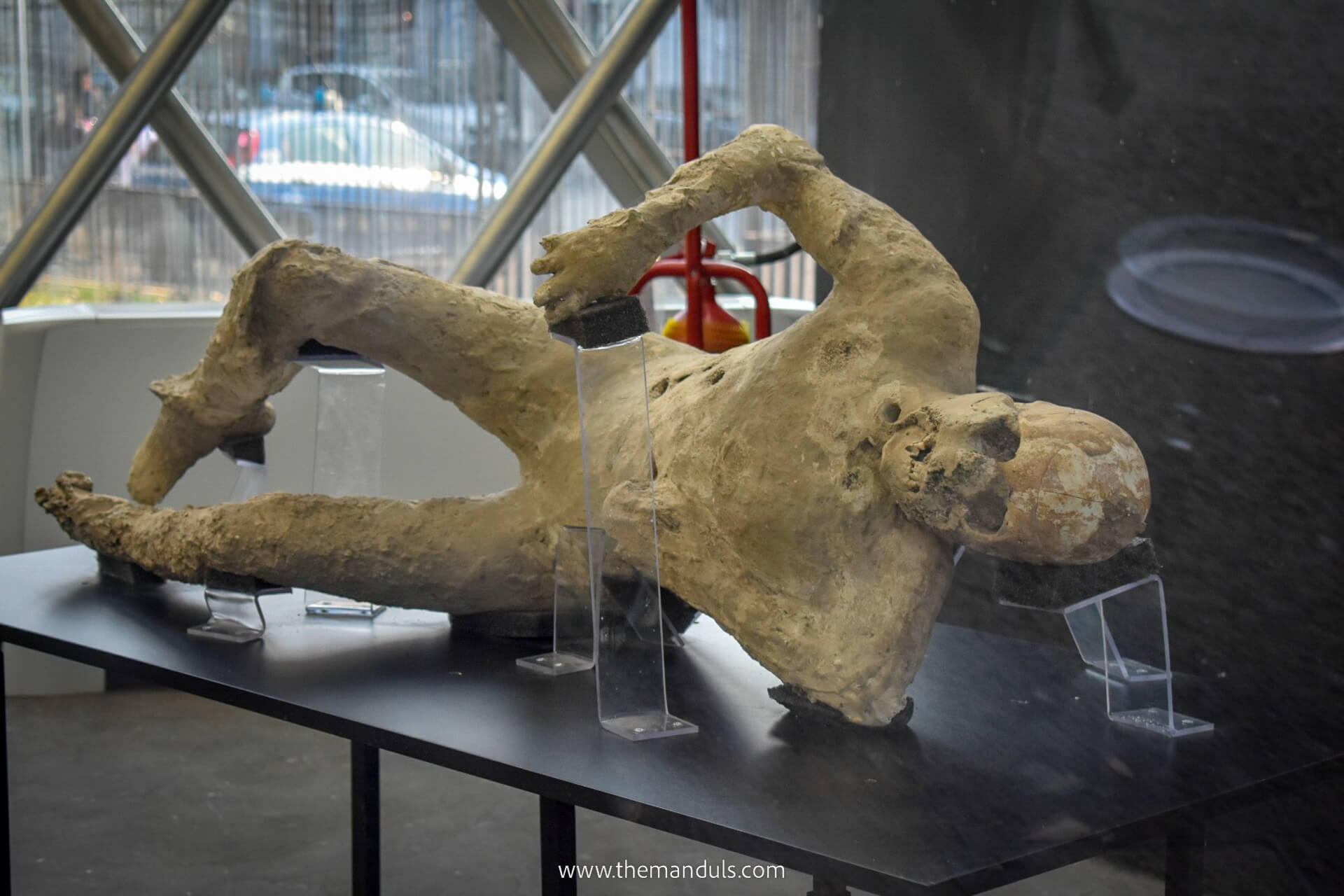
Mount Vesuvius
After exploring the ruins, we caught the local EAV bus right outside the entrance. It winds up through hills and vineyards, with incredible coastal views in the distance. The ride takes less than an hour and drops you right near the start of the walking path.
The trail to the crater rim is short but steady — about 20–30 minutes uphill on loose volcanic gravel. It’s not too difficult, but in the summer heat it can definitely take its toll, so bring water, sunscreen, and a hat. There’s no shade at all once you start climbing.
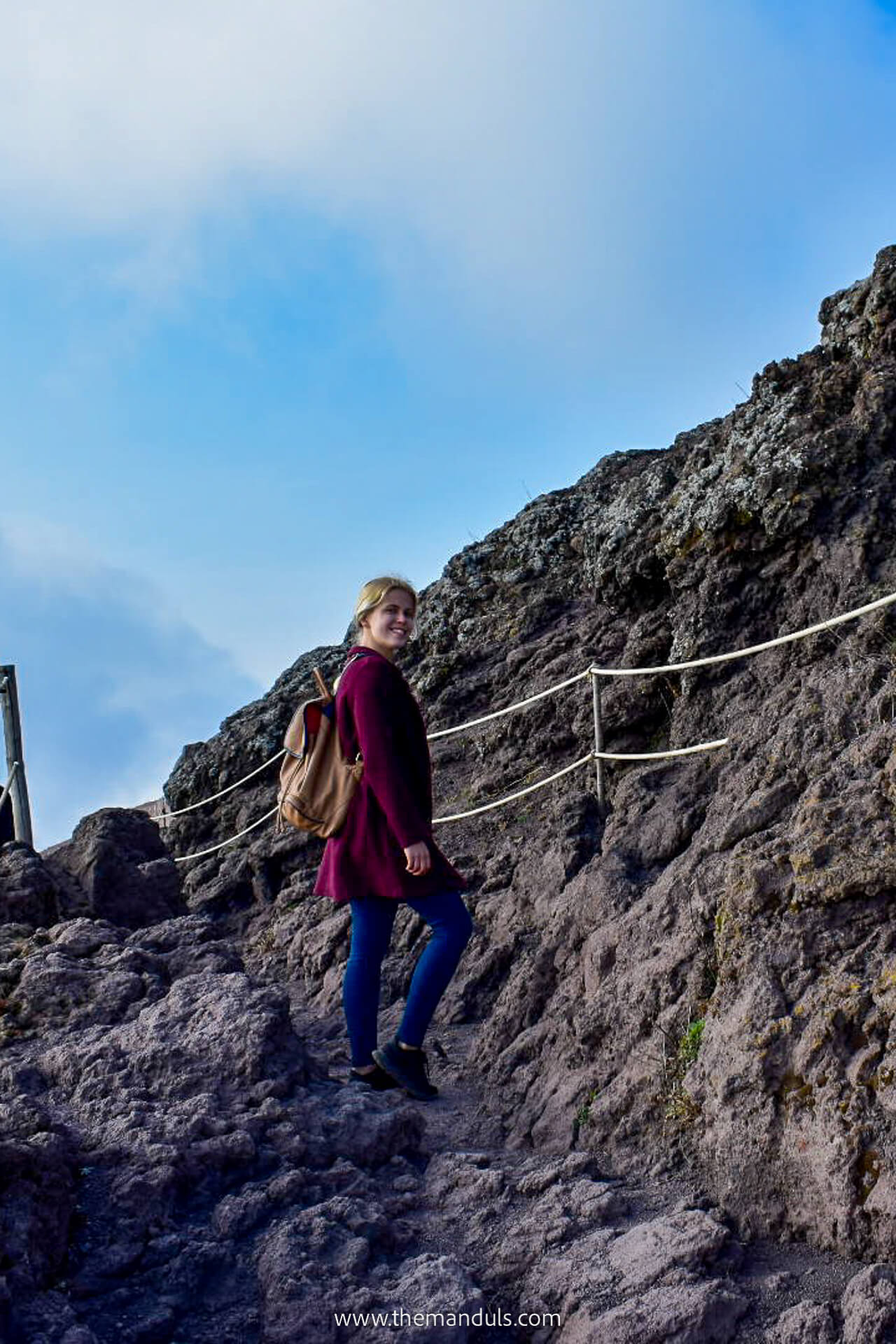
Reaching the top is a powerful moment. Standing on the edge of the volcano, looking down into the crater and out over the Bay of Naples, you really grasp the full story — both the majesty of nature and the destruction it once caused. We could still see steam rising from parts of the ground, a quiet reminder that the volcano isn’t asleep, just resting.
We spent a while walking around the rim, soaking in the views and that surreal mix of peace and power that hangs in the air. Then we headed down and continued south, finishing the day in our favorite little coastal escape — Positano and the Amalfi Coast.
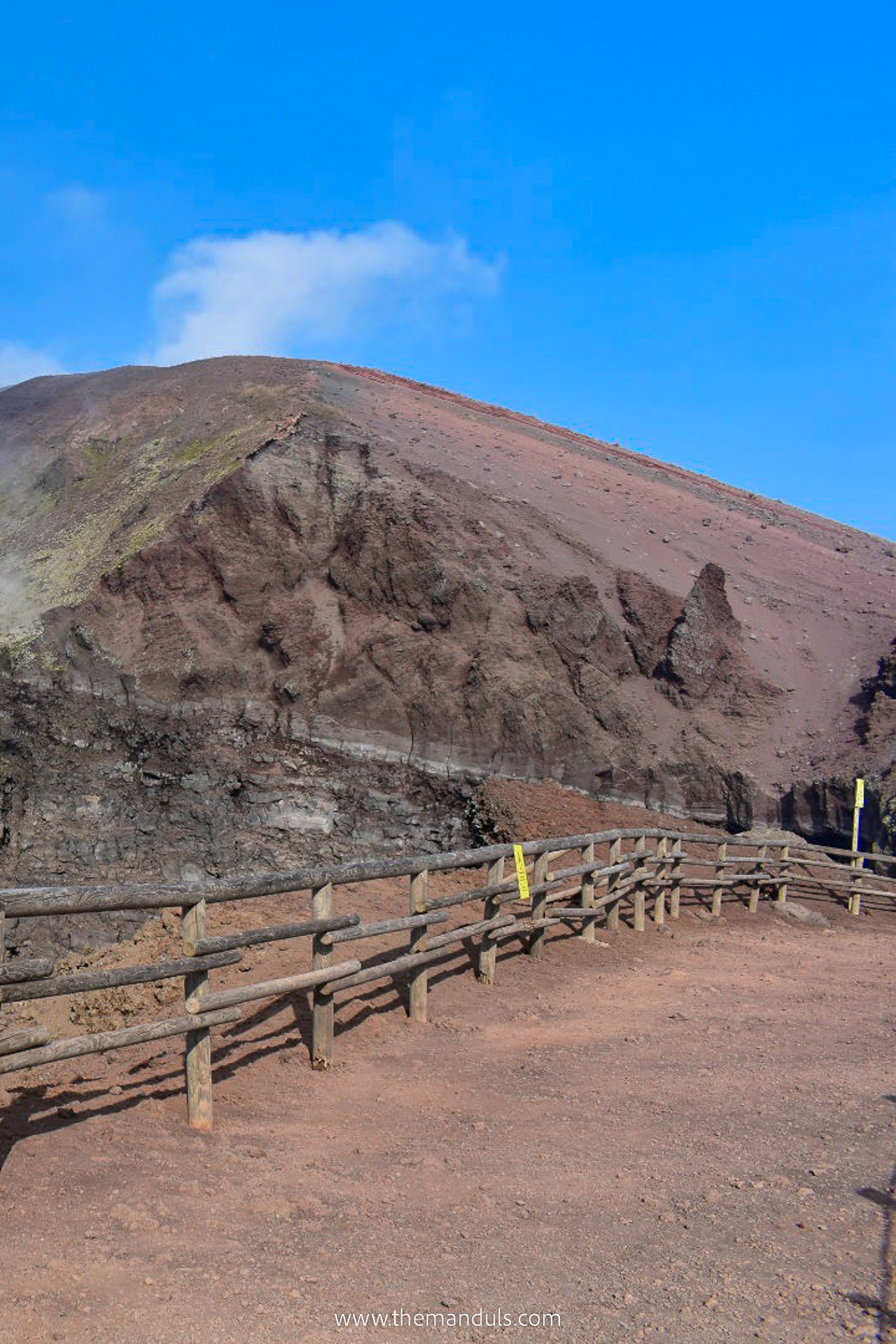
Facilities
At the archaeological site, you’ll find all the basics — toilets, cafés, drinking water fountains, and small shops near the entrances. Guided tours and audio guides are available on-site, and there’s also a luggage storage area near the Porta Marina entrance if you’re stopping by with bags.
Up at the volcano, facilities are more limited. Near the parking and ticket checkpoint, there’s a small café and souvenir shop, plus restrooms, but nothing along the walking trail itself.
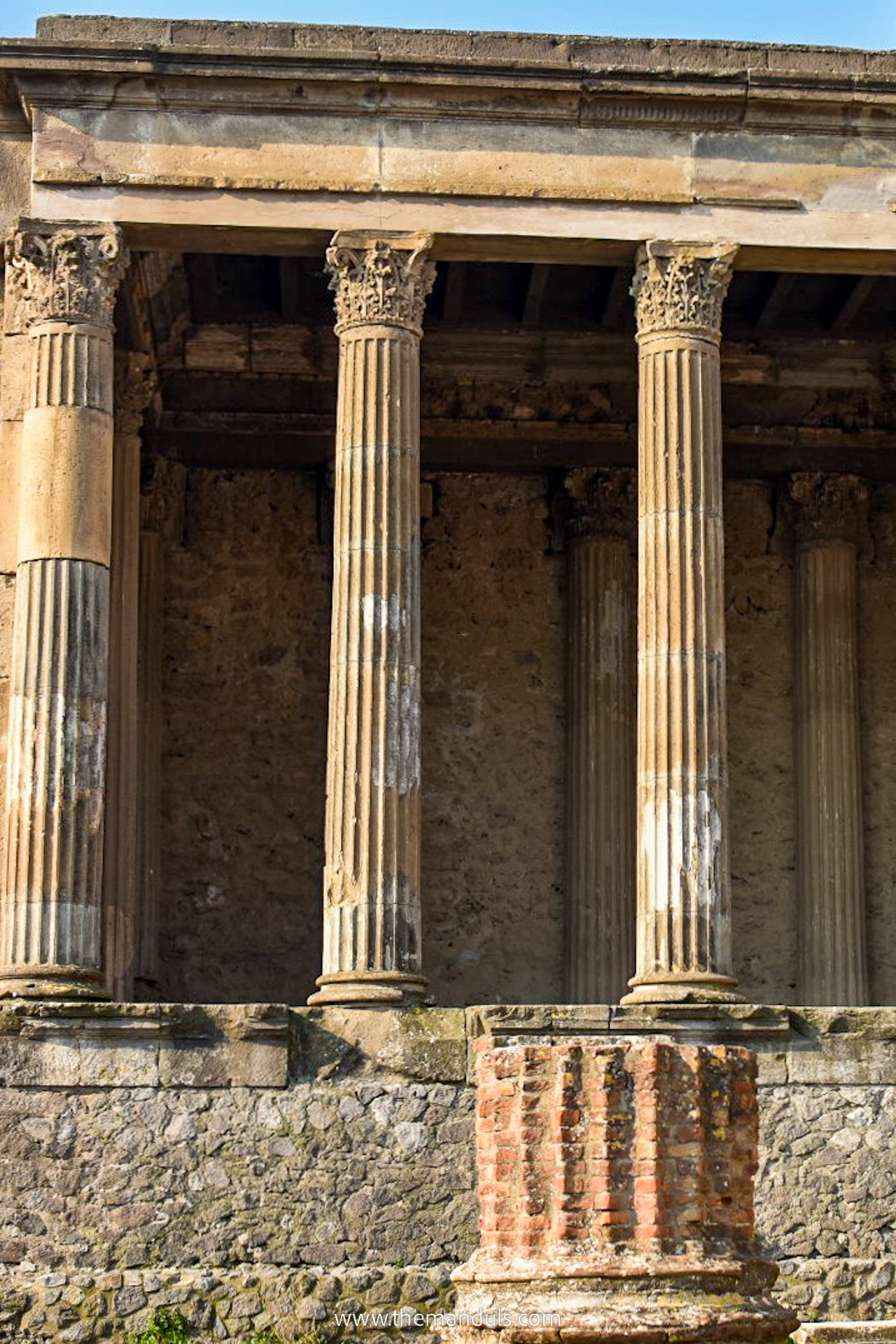
Best time to visit
The best time to visit this area is spring (March–May) or autumn (September–November), when the weather is mild and the crowds are manageable. In these months, you’ll get clear skies, comfortable hiking conditions, and far fewer tour groups than in summer.
Winter can be a great time too — that’s when we came, and it felt calm and atmospheric, with hardly anyone around. The air was crisp, and exploring the ruins without the crowds made it easier to take everything in.
Summer, on the other hand, can be intense. Temperatures easily reach above 30°C, and with little shade at either site, it can quickly become exhausting. If that’s your only option, go early in the morning to beat both the heat and the crowds.

Where to stay nearby
The best idea is to base yourself somewhere along the coast where you can easily balance sightseeing with relaxation. Sorrento and Amalfi Town are two of our favorites — both offer great connections to Naples and Vesuvius, plus that unmistakable coastal atmosphere.
If you’re still deciding which part of the Amalfi Coast suits you best, check out our full guide on where to stay on the Amalfi Coast — it breaks down the best areas, including hand-picked hotel recommendations.
Here are the ones we’d happily book again:
⭐️⭐️⭐️ Amalfi Suite Boutique Hotel (our top pick) – A stylish boutique stay right in the heart of Amalfi, with elegant rooms, modern touches, and a peaceful vibe once the day-trippers leave. Breakfast is served in-room, and everything — from the harbor to local restaurants — is just a few steps away.
Best for: Couples wanting a romantic base with style and easy access to day trips.
👉 Check current deals →

⭐️⭐️ Albergo Gatto Bianco – A Capri classic that perfectly blends timeless charm with a relaxed island atmosphere. The rooms are bright and inviting, some with terraces, and the hotel’s location just off Via Camerelle means you can explore Capri’s shops and cafés within minutes.
Best for: Couples or travelers wanting a stylish Capri stay with old-world charm.
👉 Compare prices →
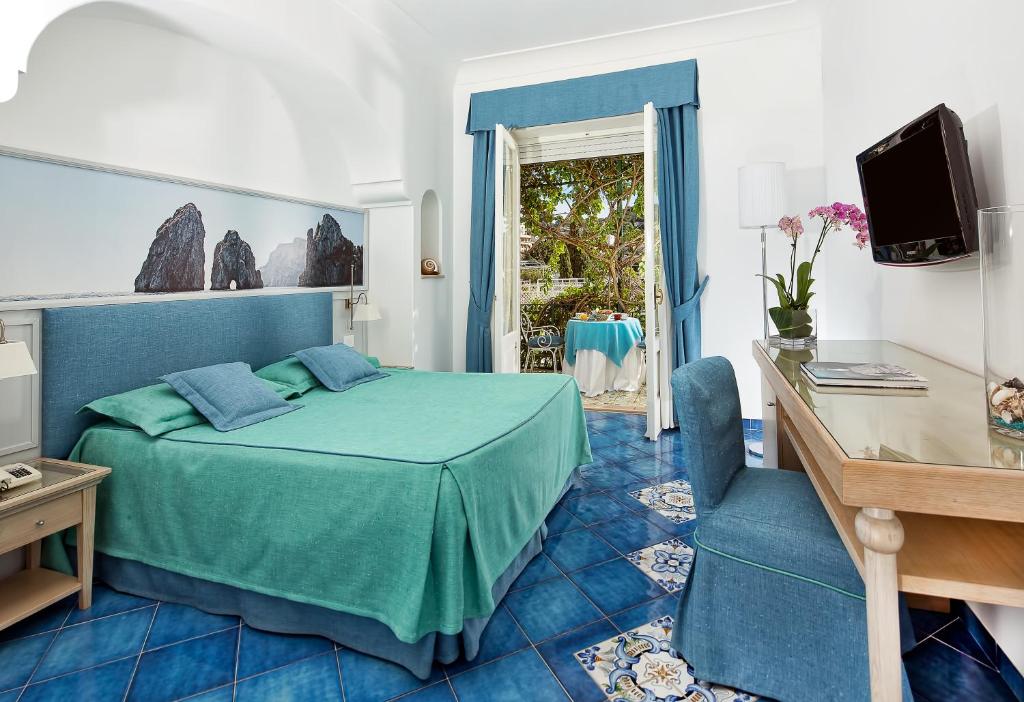
⭐️ Hotel Sorrento City – Modern, central, and great value for money, this hotel makes exploring Vesuvius and Pompeii super easy. It’s right on Corso Italia, close to the train and ferry terminals, and has a lovely rooftop terrace for a quiet evening drink after sightseeing.
Best for: First-time visitors who want comfort and easy access to trains and ferries.
👉 See availability →

Other places to visit nearby
- Naples – Just 40 minutes away, this chaotic yet captivating city is worth a full day on its own. We loved it for its authentic Neapolitan pizza, lively street life, and world-class museums like the Archaeological Museum.
- Herculaneum – A smaller, better-preserved version of Pompeii located just north of it. The details here — from frescoes to wooden furniture — are incredibly well kept.
- Sorrento – A charming coastal town perched above the sea, perfect for a relaxed afternoon or overnight stay. It’s the gateway to the Amalfi Coast and easy to reach by train or car.
- Amalfi Coast – One of Italy’s most scenic drives, and my personal favorite, dotted with colorful towns like Positano, Amalfi, and Ravello. Expect jaw-dropping views, narrow cliffside roads, and some of the best food and sunsets in the country.
- Capri – A short ferry ride from Sorrento or Naples takes you to this glamorous island famous for its Blue Grotto, luxury villas, and panoramic hikes. Ideal for a day trip.

FAQ
Yes, and it’s actually quite common. You can easily explore the ruins in the morning and head up to the volcano in the afternoon. Just make sure to start early — both places take time to walk around, and the last entry to the crater is usually mid-afternoon.
Not exactly inside, but you can walk right along the crater rim. The path circles part of the edge, offering incredible views down into the smoking crater and across the Bay of Naples.
For the archaeological site, it’s optional but smart during peak season. For the volcano, it’s mandatory — tickets must be booked online for a specific time slot, and they often sell out early.
Absolutely. Kids tend to love the “real-life ancient city” vibe of the ruins, and the volcano is a fun mini-hike. Just keep in mind that strollers aren’t practical inside the site or on the trail — a carrier is much easier.

Final Thoughts
Visiting these two sites in one day is one of those rare experiences that blend history and nature all at once. Walking through the ancient streets frozen in time and then standing at the rim of the volcano that caused it — it’s a powerful reminder of how fragile and fascinating our world can be.
We’re so glad we came in the low season, when everything felt calm and uncrowded. It gave us time to really take it in — not just as a sightseeing stop, but as a whole story.
If you’re already in southern Italy, don’t miss it. Whether you’re coming from Naples, the Amalfi Coast, or even Rome, it’s one of those day trips that stays with you long after you’ve left.

